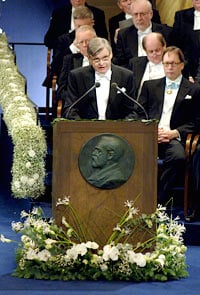Award ceremony speech
Presentation Speech by Professor Stig Stenholm, Member of the Royal Swedish Academy of Sciences, December 10, 2005.
 |
| Professor Stig Stenholm delivering the Presentation Speech for the 2005 Nobel Prize in Physics at the Stockholm Concert Hall. Copyright © Nobel Media AB 2005 Photo: Hans Mehlin |
Your Majesties, Your Royal Highnesses, Ladies and Gentlemen,
We live in a world of light. We experience our surroundings by sight. Likewise, light from the most distant galaxies gives us knowledge about the Universe. This year’s Prize is concerned with light.
Light displays a characteristic dual nature: It appears both as a wave motion but also as a stream of discrete particles of light, as photons. When a photon hits a material, it can emit one and only one electron. Light may be described by classical optics, but observing it is always based on the absorption of one quantum of energy.
Optics has been an important part of physics for a long time, and we live with its technical applications every day. Hence, physicists were slow in recognizing the need for a quantum theory of optics. The emergence of the laser, however, made it essential to distinguish its special light from the more disordered radiation emitted by hot bodies. This induced Roy Glauber to utilize the quantum theory to describe the properties of light and how these can be observed. His work laid the foundations for the field of research today called Quantum Optics. This makes it possible to test our conception of the fundamental features of reality.
These results are based on utilization of the quantum character of light. At the same time, light is a wave motion, where a precise color corresponds to a precise distance between the crests of the waves. Because the velocity of light is constant, the distance between two crests always corresponds to a definite time interval; they occur with a definite frequency. Physicists have long struggled to measure time with extreme accuracy. We need good references for time. A good reference has to be available to everybody, and hence it is chosen from the world of atoms; we have so-called atomic clocks. But a reference is not sufficient; one must also be able to establish the measure of an unknown period of time as compared with the reference. We need a measuring rod to compare two intervals of time.
John Hall and Theodor Hänsch have worked on ever-improved standard references for frequency measurements. In order to compare an unknown period of light with the reference, they have developed the frequency comb technique. This gives a sequence of exactly separated frequencies and a method to set this measuring rod against an unknown frequency. Thus one obtains an extremely accurate number for the unknown period. This allows spectroscopic measurements with extremely high precision. Today this technique is as exact as the methods developed for this purpose during earlier decades, but it promises many times improved accuracy.
The history of physics shows that, when the accuracy of measurements is improved, new physics may be discovered and explored. The work honored today facilitates tests of our basic theories in physics. The character of time and space may be clarified, and the limitations of the laws of physics may be established.
This year’s Nobel Prize explores two of the ultimate modes of behavior of light. Its lumpy quanta determine the smallest packet of energy that can be utilized in measurements. At the other extreme, its role as a perfect wave motion may act as a reference for time periods.
Professor Glauber has shown how to apply quantum considerations to all light sources. Thus he initiated the field of Quantum Optics, which today offers both challenging tasks for the scientists and promising techniques for future quantum engineering.
Professor Hall and Professor Hänsch have developed highly precise methods for spectroscopy and provided the measuring rod to compare optical signals, the frequency comb. Thus the determination of the frequency of an unknown light becomes both simpler and more exact. The present state of the art is highly precise, but future developments promise progress far beyond the achievements of today.
Professor Glauber, Professor Hall and Professor Hänsch. You have been awarded the 2005 Nobel Prize in Physics for your research into the properties of light, extending our knowledge and technology into the extremes of its dual nature. On behalf of the Royal Swedish Academy of Sciences, I convey to you the warmest congratulations. I now ask you to step forward to receive your Nobel Prizes from the hands of His Majesty the King.
Nobel Prizes and laureates
Six prizes were awarded for achievements that have conferred the greatest benefit to humankind. The 12 laureates' work and discoveries range from proteins' structures and machine learning to fighting for a world free of nuclear weapons.
See them all presented here.
